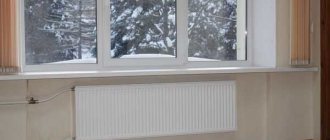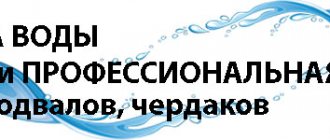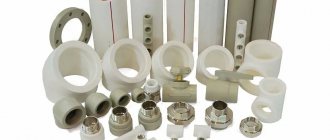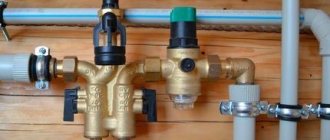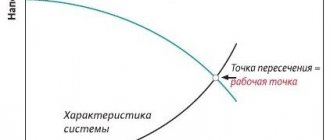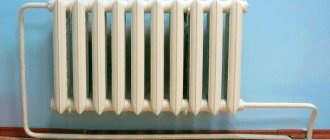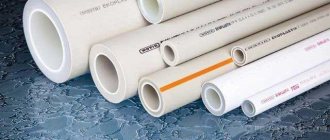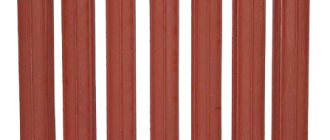Previously, the only way to organize a heating system was to use steel pipes. And today, despite the emergence of alternative options, they are still quite popular. The choice of pipe type and size is determined by several factors. These include: location (open or hidden in the floor or walls), length and complexity of the pipeline route, average and maximum coolant temperatures, pressure in the system. If it is necessary to combine several different materials, care must be taken as their technical characteristics may not be compatible.
Selection of pipes for the heating system
How to choose steel pipes for a heating system? When choosing, you must consider the following parameters:
- material used for the production of pipes;
- pipe manufacturing method;
- technical characteristics of pipes.
Selection of pipes depending on the material of manufacture
For the manufacture of steel pipes the following can be used:
- carbon steel (black);
- stainless steel.
Carbon (black) steel pipes (picture above) have the following advantages:
- low expansion coefficient when exposed to high temperature of the passing liquid;
- non-susceptibility to mechanical influences;
- low cost.
The disadvantage of this type of material is its high level of susceptibility to corrosion. To minimize the formation of corrosive plaque, the pipes are galvanized.
Zinc coated steel pipes
Stainless steel, unlike carbon steel, is less susceptible to corrosion. Stainless steel is also different:
- resistance to mechanical stress;
- low expansion coefficient;
- aesthetic appearance, which avoids the need to cover pipes with various decorative elements.
However, the cost of stainless steel pipes is significantly higher.
Steel pipes made of stainless steel
Selection of pipes depending on the manufacturing method
Pipes for the heating system can be manufactured using one of the following methods:
welding Welded pipes can have a straight seam (straight seam) or a spiral seam (spiral seam). Straight-seam pipes have a significant drawback - the seam, which can be damaged when exposed to temperature and high pressure. Therefore, the heating system with steel pipes is mainly made of spiral-welded pipes;
Welded steel pipes with a spiral seam
by pulling (rolling). Pipes made in this way do not have a welded seam (seamless tubes), which significantly increases their technical characteristics (resistance to temperature and pressure). However, the cost of seamless pipes is higher than welded ones, which limits their use (used to create heating systems in harsh climates or with high pressure).
Rolled pipes
To install heating systems in a private house or city apartment, both straight-seam and spiral-seam pipes can be used, since the pressure in the system does not exceed the calculated parameters of the pipes obtained after testing.
Selection of diameter and other technical characteristics
The main technical parameter when choosing steel pipes for building a heating system is the diameter.
The diameter of the pipes depends on such indicators as:
- coolant temperature at the system inlet;
- coolant temperature at the outlet of the system;
- the amount of heat required to heat the room;
- the speed of movement of the coolant in the system.
Taking into account all the indicators for calculation, you can use the mathematical formula:
Calculation of pipe diameter for a heating system
In the presented formula, the letters indicate the following parameters:
- D – claim diameter;
- Q – amount of heat (equipment power);
- ∆t° – temperature difference at the inlet and outlet of the coolant;
- V – speed of movement.
In order not to make complex mathematical calculations, you can use tables that have been developed by specialists based on the specified formula.
Diameter table
For example, to equip a heating system with a heating equipment power of 2.4 kW, pipes with a diameter of 8 - 10 mm will be required.
If you install pipes of a smaller diameter in the system, the amount of heat will not be enough to heat the room. When installing pipes of larger diameter, noise will occur when the coolant moves.
What diameters are there?
In the technical parameters of heating pipes, different types of sections are used. When taking into account the mounting structures and the occupied area, take the outer diameter with the walls. Internal characteristics indicate the size of the gaps, therefore they are suitable when calculating network throughput. The conditional version is an averaging to the larger side of the space inside.
In stores, pipes are marked by their outer cross-section, often in inches (25.4 mm). Internal parameters vary depending on the wall thickness, material and purpose of the part. The external characteristics of steel seam models are 3-4% thicker than those of polymer and seamless structures. Copper types are the thinnest, 1-2 mm smaller than others.
Analysis of popular types Source alchevsk.ua
The size of the heating pipes affects the tasks that the element must perform. Popular diameter parameters range from 16 to 40 mm:
- 16. Used to connect one or two batteries.
- 20. Suitable for installing 1 radiator or a group of up to 5 pieces. The total maximum power is 7 kW.
- 25. Models are used for installing heating structures with dead-end wiring diagrams.
- 32. Used for arranging the utility network of an entire floor or cottage, with a total capacity of up to 19 kW.
- 40. Suitable for 20 batteries, up to 30 kW.
The choice of cross-section of heating pipes determines the throughput capabilities of the system, hydraulic and heat losses. The bulk coolant heats up quickly, and the small size provides better resistance and low noise. Elements of small diameter are cheaper than large ones. Models that are too compact create increased load on the reinforcement, which leads to gusts.
Selection criteria
When determining which pipes are best used for heating an apartment or individual house, consider their following physical and operational parameters:
Corrosion resistance. Since water or antifreeze containing it flows in heating circuits, heating pipes must have high corrosion resistance. Strength. The standard pressure in the heating system does not exceed 2 atmospheres; the pipeline should easily withstand this pressure with a margin of 1.5 - 2 times. Temperature characteristics. The temperature of the medium in the heating circuit rarely exceeds 70 °C; for heated floors, the limit value is about 50 °C. It is clear that the pipeline must withstand temperature parameters with a reserve in case of emergency situations - overheating of the coolant due to automatic malfunctions, boiler malfunctions. Thermal conductivity. Heating pipes transport coolant to radiators or are themselves heat exchangers, transferring thermal energy to the floor screed
In the first case, their thermal conductivity does not play an important role, and its high degree is even undesirable. When working in underfloor heating circuits, on the contrary, high heat transfer is required, so the thermal conductivity of the pipeline must be the highest.
Rice. 2 Extension of a 100 meter section of pipes when heated to 50 °C
- Thermal expansion coefficient. It is well known that all materials expand to one degree or another when heated, this especially affects polymers. If pipes for heating systems are placed on walls or under a bulk screed, it is necessary to take into account this feature of plastics and choose a material with the lowest linear coefficient.
- Difficult to install. To connect pipeline sections, different methods are used depending on the pipe materials; most technologies require the use of special expensive tools and skills to work with them.
There are also methods for connecting plastic pipes with removable compression-type fittings, where the main tool is a regular adjustable wrench. And a little-known novelty in plumbing - a push fitting - allows you to join two sections of cross-linked polyethylene pipes within a couple of seconds with one click.
Dimensions
During installation, the contour of underfloor heating can be 100 meters or more in length, so it is important that the pipeline used is of the appropriate size to avoid unwanted joints under the screed. Chemical resistance
The heating pipeline is often placed in the walls or screed, and antifreezes - ethylene glycol, propylene glycol - are passed through it. Therefore, one of the main requirements for the pipeline is resistance to aggressive chemicals.
Rice. 3 The main types of installation of transition fittings on pipes: pressing (for PEX-AL-PEX), PEX compression connection, pressing with a tension coupling (for PEX), PP soldering, pressing of thin-walled stainless steel
Durability. Heating pipes must withstand long-term operation (according to state standards, at least 50 years), while it should be taken into account that for polymers, the service life is highly dependent on the temperature parameters of the coolant and the pressure in the line. Hydraulic characteristics. The inner walls of heating pipes in apartments and individual buildings must have low hydraulic resistance to water flow, that is, be perfectly smooth. This contributes to high system efficiency and reduces operating costs (energy consumption of the circulation pump). Breathability. Oxygen present in the coolant is a strong oxidizer of metals; corrosion destroys heating elements, boiler parts and steel fittings in the system
Therefore, it is important that the pipe shell does not allow air to pass through; this requirement is irrelevant for metals due to their high density and is important when using polymer pipelines in the heating circuit. Cost The main criterion that people immediately pay attention to when installing heating is precisely due to their lower price, plastic products are in the highest demand among the population
Pros and cons of metal pipes
Advantages of metal products:
- Strength. Steel, copper and cast iron can withstand much greater pressure than plastic and are much more resistant to water hammer.
- Strength as a guarantee of non-destruction of pipes when working in workshops - often in production conditions there is a possibility of their damage during the operation of lifting mechanisms, equipment, and emergency situations in hot workshops. When laying heating openly between buildings, sufficient structural strength is also required - metal changes its geometry less when heated, metal is more resistant to vandalism.
- Fire resistance.
- Resistance to temperature fluctuations.
- Harmless to humans.
- UV resistance.
- A welded system is generally more airtight than prefabricated structures, and when installing gas systems this can be critical.
- Low thermal expansion - metal does not sag and does not change configuration when heated, like plastic.
- Long service life.
- Thermal conductivity. A metal heating system serves as an additional source of heat in the room; When laying pipes along the perimeter of the building, you can slightly warm up the corners of the rooms, increase air movement in them and protect them from the occurrence of dampness, mildew and mold.
Common disadvantages of metal pipes:
- For steel and cast iron – prone to corrosion/
- Heavy weight.
- For steel and cast iron – overgrowing of the inner surface with calcium and magnesium salts.
- Difficult installation using welding or threaded fittings.
Types of steel pipes
The metallurgical industry produces only three types of rolled steel pipes.
Black steel. Pipe products of this type were widely used in the 70s - 90s of the last century in the creation of water supply and heating pipelines. Most often, an electric-welded VGP pipe was used for this purpose, the technical characteristics of which meet the requirements of GOST 3262-75.
Welded pipes are often used for the construction of heating mains; such pipes can be straight-welded or spiral-welded
Helpful information! Many home craftsmen, when choosing elements of a heating system, take into account, along with the service life of steel heating pipes, the fact that they are easily welded, and thereby facilitate the installation of the system. The main disadvantage of rolled metal products of this type is susceptibility to corrosion upon contact with water.
For this reason, rust flakes appear in the coolant, and the pipes themselves become overgrown with deposits. The combination of these factors entails a decrease in the throughput of the heating pipeline. This is why you can buy steel pipes today at a relatively low price, but you will have to change them quite often
The main disadvantage of rolled metal products of this type is their susceptibility to corrosion upon contact with water. For this reason, rust flakes appear in the coolant, and the pipes themselves become overgrown with deposits. The combination of these factors entails a decrease in the throughput of the heating pipeline. That is why you can buy steel pipes today at a relatively low price, but you will have to change them quite often.
Cink Steel. The zinc coating layer, as mentioned above, is designed to counteract the phenomenon of corrosion and increase the service life of pipe products made of black steel. Galvanizing does not cope with the task completely, but only slows down the corrosion of the base metal.
According to experts, galvanization is the most stable and durable material, the technical characteristics of which make it possible to create centralized heating with its unpredictable pressure surges and temperature schedule. In autonomous heating systems that allow operational control of operating parameters, cheaper pipes made of metal-plastic and polypropylene can be installed.
Galvanized heating pipeline elements have only two serious drawbacks:
- the welded joint breaks the zinc layer inside the pipe, creating a vulnerable spot for corrosion. This inevitably leads to a reduction in the service life of the heating system. And installation on a thread will take a lot of time and effort.
- the cost of galvanized products is much higher than the price of heating pipes made of black steel, metal-plastic or plastic.
Heating pipes should be galvanized or stainless steel; they are resistant to corrosion and last longer than usual
Stainless steel. Theoretically, the use of seamless or welded stainless steel pipes makes risers and liners almost eternal. But this solution is not popular due to the difficulty of processing corrosion-resistant steels and their high cost.
Against this background, the use of corrugated stainless steel pipe seems much more advantageous.
- during installation, you can get by with a pair of gas wrenches and an inexpensive pipe cutter;
- The recommended operating pressure at a temperature of +100˚С is. This indicator is not available to any plastic;
- pipes can take on any complex configuration and are easily bent by hand.
Note! If there are small children in your family, they will inevitably use the radiator connections as a crossbar or support, which will cause deformation of these elements of the heating pipeline. And stainless steel, in fact, like any metal, when bent repeatedly, loses strength and can even break.
Briefly about the cost where to buy
The price of metal structures is indicated either per meter or per ton. Be sure to pay attention to this point. The cost of metal channels varies over a very wide range. The price depends on the quality of the material, production technology, wall thickness and other properties of the product.
Structures made of black steel are the cheapest. Next comes galvanization, which costs a little more. Stainless steel is the most expensive. However, as you have already learned, pipes made from it are the most reliable. Corrugated stainless steel channels are the most expensive.
The easiest way to order the products in question is from companies specializing in the sale of rolled metal products. It is advisable to deal with structural manufacturers or their official dealers. This will allow you to purchase the products you need at an affordable price.
In some cases, it makes sense to buy used pipes. The main thing is that they are in good condition. When purchasing, be sure to ask for a certificate of conformity. This will allow you to avoid purchasing inferior products.
Criteria for choosing metal pipes for heating
When building a house and installing a heating system with your own hands, the main question arises - which metal pipes are better? As you know, metals used for communications are classified as:
- black;
- color;
- alloys.
The first category includes rolled steel, galvanized iron and cast iron. Non-ferrous metals do not rust, but oxidize, these are:
- bronze;
- copper;
- aluminum, etc.
The type and layout of the heating system are one of the decisive factors when choosing pipes for the network
Main selection criteria:
- type of heating system (gravity or forced);
- maximum load (the conditions of the northern regions differ from the heating period of the southern latitudes);
- the ability to replace sections of the pipeline with the greatest load;
- installation method (hidden or closed, inside the walls);
- general configuration of the system, including the number of floors of a private house;
- design and maximum pressure inside;
- type of coolant;
- possibilities for transportation and installation with your own hands;
- total length and budget framework for installation;
- the maximum possible temperature in the system.
Questions about selecting the diameter of the heating pipeline
Pipes are produced in standard diameters, from which you need to make a choice. Standard solutions have been developed for selecting pipe diameters for heating a house, based on which in 99% of cases you can make the optimal correct choice of diameter without performing a hydraulic calculation.
Standard outer diameters of polypropylene pipes are 16, 20, 25, 32, 40 mm. The internal diameter of PN25 pipes corresponding to these values is 10.6, 13.2, 16.6, 21.2, 26.6 mm, respectively.
More detailed information on the outer diameters, inner diameters and wall thickness of polypropylene pipes is given in the table.
Welding methods for straight-seam pipes
Pipe products, manufactured by bending a steel sheet (strip) into a circle and connecting its joints, are welded using several different technologies.
Furnace welding
The steel strip (strip) entering the rolling mill to give it a round shape is preheated in a tunnel furnace to a temperature of about 1300 °C. Approaching the rolling rollers, the side nozzles additionally heat the edges of the pipe with hot air to a temperature of about 1400 °C. Similar nozzles are installed in the roller zone of the forming mill and heat the edges of the strip to 1400 °C before directly bending the sheet into a circle with the extreme edges in contact.
After joining the edges, heated to high temperatures under pressure by rollers, a strong seam is formed, obtained by the method of mutual diffusion of molten metals. Next, the pipe is once again pulled through a furnace with forming rolls to give it the correct geometric shape. The technology refers to types of steel processing using hot deformation.
Rice. 5 Scheme of furnace and electric arc welding in a flux environment
Electric welding
Electric welding is more often used than other methods when welding round pipes; it allows you to obtain a high-quality seam on thin walls. Pipe products used for pipelines in the oil and gas industry are manufactured using submerged arc welding. To carry out welding work, a round-shaped pipe shell is formed in a forming rolling mill; if the diameter of the product is too large, the circle is assembled from two sheets, which are molded under a press until a semicircular shape is obtained.
Automatic electric welding is carried out simultaneously from both sides until a uniformly welded longitudinal seam is obtained; wire is used as an electrode. After removing the grand, ultrasonic testing and hydrotesting, the pipe is ready for use.
Rice. 6 Electric welding in inert gases - principle
Electric welding in shielding gas
The disadvantage of welding in air is the harmful effect of oxygen on the joint; as a result, air bubbles form in the seam strip, its chemical composition changes due to carbidization of alloying elements, and scale appears on the surface.
The use of inert shielding gases in the field of welding: carbon dioxide, argon and helium allows you to get rid of these harmful factors that arise due to the influence of environmental oxygen on the metal. During operation, neutral gases, being heavier than air, displace it from the working area, eliminating contact of the molten weld pool with atmospheric oxygen. Refractory tungsten products are used as electrodes.
Welding in an inert gas environment is more often used to connect parts made of stainless or high-alloy steel; the seams are characterized by homogeneity of the material, uniform thickness, high surface quality, and provide excellent tightness and strength of the joint.
Pipe products produced by electric welding belong to the group of cold-deformed products.
Rice. 7 HDTV welding schemes
High frequency (induction) welding
The modern high-speed method of pressure welding (pressing melted edges against each other with physical force), in which the edges of the workpiece are heated by high-frequency high-frequency currents until softening, is widely used in pipe production. The current density is maximum in the surface layer of the product and sharply decreases when immersed deep into the workpiece (surface effect), due to which only a thin layer of the outer shell with a depth of 0.1 - 0.15 mm is strongly heated.
Heating of the joining edges is carried out by an inductor located in close proximity to their edges; it generates induction currents along the edges of the workpiece using two electrodes sliding along the pipe shell.
During induction welding, the joined pipe edges of the workpiece have the shape of the letter Y; the HDFs are brought to the edges by means of an inductor or a rotary roller so that it passes through the point of their convergence. The distance from the conductive contacts to the junction varies in the range from 25 to 300 mm.
There are several induction welding technologies; to connect pipe edges made of ferrous and non-ferrous metals, the pressure welding technique with fusion is most often used. The heating rate with this technology is 15·104 °C/s, precipitation is 2000 mm/s, the technology ensures high quality welding joints.
Rice. 8 Physical parameters of metals of heat-treated and hot-reduced straight-seam pipes of classes A and B (GOST 10705-80)
Seamless pipelines
Seamless steel pipe for heating is produced by hot deformation from a monolithic part, which has the shape of a cylinder. They are called differently - solid-bent.
Specifications
This rolled metal product does not contain any seams or joints. They are made on special machines.
Depending on the type of production, seamless materials can be hot-rolled, solid-formed or cold-rolled.
Solid bent products get their name from the production method. This type of building materials is characterized by high strength. Also, seamless options are classified as thick-walled blanks.
In this case, a special type of steel is used for production. Various non-ferrous metals are also used for such production. This is used for pipe rolling, which transports aggressive chemicals.
When talking about this type of product, one cannot ignore an interesting fact. Hot-rolled pipes are widely used in cryogenic technology.
The principle of using and installing heating with steel pipes
The use of steel pipes is advisable when large diameters and mechanical strength are required. Laying pipes is quite problematic due to the difficulty of giving them the required geometry. In addition, it is recommended to insulate the pipes due to their significant thermal conductivity coefficient.
If you have a floor-standing boiler with natural circulation, the use of “black” steel will be optimal. This raw material quickly rusts in the water supply system. But, in an autonomous heating system, with long-term circulation of coolant and rapid oxygen evaporation, the service life of black pipes can last about 50 years.
When using wall-mounted boilers equipped with a copper heat exchanger and forced circulation (pump), the use of steel pipes becomes impractical. This is due to the unaesthetic nature of such a system, corrosive clogging of the thinnest heat exchanger and high installation costs. Therefore, it is advisable to dismantle steel pipes using copper or plastic raw materials.
To assemble steel pipes, you need a device for cutting pipes and threads, an adjustable and gas wrench, a hacksaw, welding, and sealing tape to seal all connections. When purchasing non-galvanized pipes, they must be painted with asphalt varnish. If the pipes are factory galvanized, there is no need to further process the pipes. If you prefer open pipe laying, you need to take care of the mounting clamps. The attachment points can be located at the following distances:
- 2.5 meters if the internal diameter of the labor is up to 20 millimeters;
- approximately 3 meters with a diameter of 25 millimeters and above;
- 4 meters with an internal diameter of 40 millimeters.
For bending steel pipes, it is advisable to use a hydraulic pipe bender, which is a small-sized, convenient and easily transported device that is energy efficient. If such a tool is not available, then it is possible to purchase ready-made steel fittings of the required shape, ensuring the connection of straight sections in a pipeline bend. Today, choosing fittings is not a difficult task, since manufacturers offer a sufficient range of them.
Metal-plastic pipes (MP, PEX-AL-PEX, PP-AL-PP, PE-AL-PE)
Synthesis of the positive qualities of metal and plastic pipes.
Advantages.
- Resistance to temperature changes
- Easy to install
- Flexibility
- Minimum linear stretch
- Versatility of installation
- Affordable price
- Service life 30 years
- Attractive appearance of pipes and fittings.
Metal-plastic pipes are sold in coils up to 50 meters long and allow you to install a heating system with a minimum number of connections. The flexibility of the pipe allows for turns of 90° with a minimum radius. Excellently recommended in underfloor heating systems and when installed inside walls. Installation is convenient because there is no pipe waste.
Flaws
The main complaints from consumers relate not so much to the pipes themselves, but to the cost of fittings for metal-plastic pipes. A significant drawback of the connecting elements is the narrowed cross-section compared to the base pipe. Constant monitoring of the uninterrupted operation of the boiler is necessary. If it stops in the absence of the owners and the water freezes, a burst of the system will inevitably occur. Therefore, it is better to fill the system with antifreeze with an operating temperature of up to +95C.
Installation of metal-plastic pipes provides a wider choice of installation options. They are connected in three ways:
- Plug-in connection
- Conditionally - detachable
- One-piece
For more details on metal-plastic pipes, see the video:
Which pipes to choose for organizing a heating system
Choosing pipes for heating a private house is a responsible process, during which you should take into account the area of the room, whether it is heated or not, what the power of the boiler is, etc. To create a high-quality system, it is better to use polypropylene pipes. They are inexpensive, highly airtight and easy to install. Installation takes little time, unlike calculations and preparatory work. To ensure that the system works for a long time and does not require maintenance, it is better to choose reinforced pipes and taps made of stainless steel.
Metal-plastic pipes are a good, but more expensive option. For installation, all you need is a wrench. The main disadvantage of the products is the low service life of the connections. Such pipes should only be used for heated rooms. If your budget allows, it is better to purchase stainless steel pipes. They are more expensive, but will last at least 100 years.
Heating pipe diameter
Another important stage in organizing the system is choosing the diameter of the pipes for heating a private house. Products are presented in different diameters.
To choose the right one, you should study the system diagram and contact a specialist. The approximate diameter can be calculated independently, taking into account the area of the room and the speed of movement of the coolant.
There is a misconception that installing large-diameter pipes is the key to efficient operation of the system. In fact, due to massive pipes, the pressure in the system decreases or disappears. As a result, water is not able to get into all radiators. Smaller diameter pipes have a higher water flow rate. The optimal value is from 0.2 to 1.5 m/s. If the speed is too high, water bubbling can be heard in the coolant.
To select the appropriate diameter, the thermal power is calculated. For example, for a room with ceilings up to 3 meters high, 100 watts of energy is needed for every square meter. For a room of 20 square meters you will need 2000 W. If you add 20% of the reserve, you get 2400 W. Thermal power is provided by the presence of 1-2 radiators installed under the windows. According to the table, pipes with a diameter of 8-10 mm are suitable for this room. These are approximate calculations, but they will help you calculate your budget when renovating your home.
Heating installation is an important stage that is carried out immediately after the construction of the house. It is worth taking a responsible approach to the choice of pipes, since they are the main elements of the system. They must be strong, durable, resistant to changes in temperature and pressure. When choosing products, it is worth considering a lot of nuances. This is the area of the room, whether it is heated or not, and the method of laying communications. There is no need to skimp on organizing your heating system. High-quality materials will last up to 100 years, maintaining performance characteristics. You should choose products from trusted manufacturers, since even the slightest violation of manufacturing technology significantly impairs performance properties.
Types of coolant movement
The speed of movement of the hot water flow in the pipes is one of the important parameters that allows you to calculate the diameter of the parts. The recommended movement ranges from 0.26 to 1.4 m/sec. Already at 1.5, heat transfer decreases and noise in the utility network increases. There are 2 types that you need to understand.
Pipe size options Source prootoplenie.com
Convection
The natural circulation option is suitable for solid fuel boilers. The operating principle is based on physical laws. The density of a cold liquid is less than that of a hot one. Cool moisture flowing down the pipe displaces warm moisture upward. The speed of movement in such networks is 0.2 m/sec.
A small flow of movement during convection circulation causes the formation of air jams and a decrease in the volume of transferred heat. The expansion tank and Mayevsky taps will help solve the problems.
System with convection movement Source aniko-gas.ru
The diameter of the heating parts with convection circulation must match the boiler outlet pipe. The largest starting section is maintained until the first fork. When laying, the size of the pipes is gradually reduced. In the last node, the characteristics of the elements vary between 16-19 mm.
Forced
Circulation in the circuit is carried out using a pump and a manifold, which are included in the design of the boiler (gas, electric). The user can independently control the speed of the coolant. In engineering networks, parameters are maintained within the range of 0.7-1.2 m/sec.
In options with forced circulation, it is advisable to use pipes of small diameter. In a circuit with a small volume, it is faster and easier to heat water, which increases the efficiency of the design. Installing and masking thin parts is much easier than thick counterparts.
Forced circulation in the system Source eco-kotly.ru
The cross-section of networks with forced circulation often depends on the heating connection diagram. The size for radial connection from equipment to pipes is 19 mm, for single-pipe and double-pipe - 25 mm. The parameter is not final and is calculated based on the characteristics of the boiler and cottage.
Steel 12Х1МФ
Low-alloy, heat-resistant structural steel. Pearlitic grade steel. Recommended application temperature up to 570-585 °C; Temperature of intensive scaling 600 °C; operating life - more than 10,000 hours.
Substitute: 12ХМФ.
Type of supply: Pipes TU 14-3р-55-2001, including long and shaped steel.
Application: For superheater pipes, pipelines and high pressure manifold installations; forgings for steam boilers and steam pipelines; gas turbine cylinder parts; for the manufacture of parts operating at temperatures of 540-580°C.
Steel 30HGSA
Structural alloy steel. Chrome-silicon-manganese steel.
Substitute : 40HFA, 35ХМ, 40ХН, 25ХГСА, 35ХГСА.
Type of delivery: seamless hot-rolled pipes
Application: Various parts to be improved: shafts, axles, gears, flanges, casings, compressor blades operating at temperatures up to 200°C, levers, pushers, critical welded structures operating under alternating loads, fasteners operating at low temperatures .
Varieties and main regulatory standards
Like most others, this type of metal products is produced in two main ways: hot rolling and cold deformation.
Hot-rolled seamless metal pipe is produced according to:
- technical requirements specified in GOST 8731-74,
- assortment according to GOST 8732-78.
Cold-formed products are manufactured according to:
- GOST 8733-74 – technical requirements,
- GOST 8734-75 – assortment.
Steel 15GS
Low-alloy structural steel for welded structures.
Substitute: 12GS, 16GS.
Type of supply: Boiler pipes according to TU 14-3r-55-2001.
Application: Stationary feed water pipelines of SVP boilers operating at a temperature of 280°C. As well as truss posts, top frames of cars, center beams, I-beams and other parts of car construction, parts of excavators, elements of welded metal structures and other parts operating at temperatures from -40 to +450°C.
